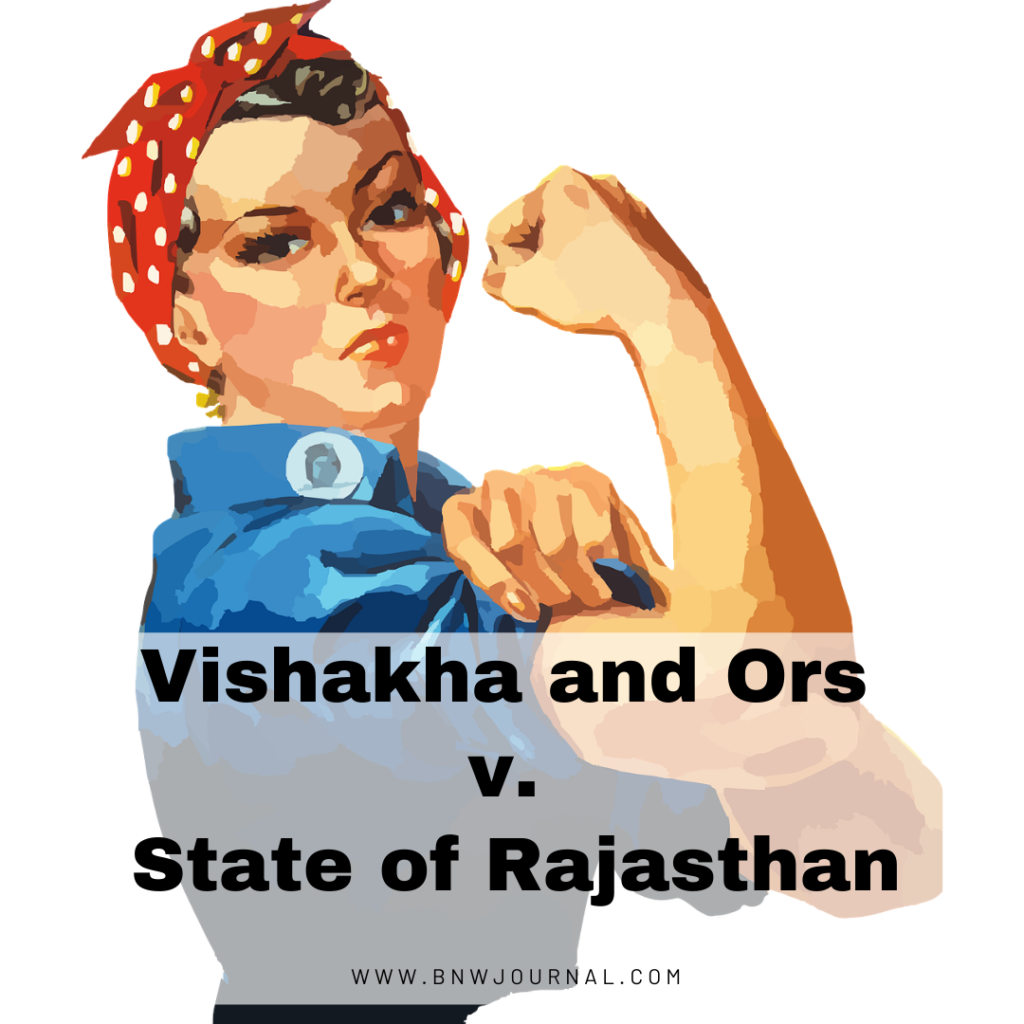![]()
Introduction
The contribution of women in today’s society is undeniable. The growth and development of our nation today has brought a radical change in the status of women. There were days when men were the sole earners of the family. In the present era, Indian women not only take care of their respective households but have also try to create their own identities through education and gaining sufficient knowledge to come at par with the men.

However, various cases of sexual harassment at the workplace have only discouraged women from moving towards success and development. One such case under the Supreme Court of India is the case of Vishakha v. State of Rajasthan which is remarkably a landmark judgment in the history of sexual harassment of women at the workplace. This case is part of an important step the Supreme Court took to curb sexual harassment at the workplace; and to protect and safeguard working women. The judgment set forward certain commitments for the employers to prevent sexual harassment.
Facts of the Case
Bhanwari Devi was a social worker in a program initiated by the State Government of Rajasthan; She aims to curb the evil of Child Marriage amidst the protest to stop child marriages in Ramakant Gujjar’s family. She tried her level best to stop that marriage. However, the marriage was successful despite the protest.
To seek revenge, Ramakant Gujjar and 5 more men gang-raped her in front of her husband. The Police Department diverted her from filing the case, however with all determination, she filed a complaint against the accused. The female police constables gave them a cruel treatment. And it was to the extent that her lehenga was demanded for gathering evidence. To add on to the existing ruckus, the police denied their request to spend the night at the station.
The trial court acquitted the accused but she did not lose hope. The other women provided further support which made her more determined and courageous. The women together filed a writ petition before the Supreme Court of India under the name of “Vishakha”. The Apex Court then got an invite to frame guidelines for the prevention of Sexual Harassment at the workplace. The Articles under which the violation of case took place are as under:
- Article14: The State shall not deny to any person equality before the law or the equal protection of the laws within the territory of India.
- Article15: Prohibits discrimination of Indians based on religion, race, caste, sex or place of birth.
- Article19(1)(g): Right to practice any profession or to carry on any occupation, trade or business to all the citizens residing within the jurisdiction of the country.
Article 23(1) of the Universal Declaration of Human Rights: Everyone has the right to work, to free choice of employment, to just and favorable conditions of work and to protection against unemployment.
Article 21: No person shall be deprived of his life or personal liberty except according to the procedures established by law.
Guidelines issued in the year 1997
The Court to bring about gender equality and non-discrimination and to restrict gender disparity issued the following guidelines:
- The employer or other responsible persons at the workplace are responsible to prevent or deter the commission of sexual harassment.
- Procedures for resolution of the same shall also be provided.
- A proper and meaningful definition for the term “Sexual Harassment” was given which is as under:
- Disagreeable sexually determined behavior.
- Sexually colored remarks.
- A demand or request for sexual favors.
- Sexually implicit physical contact.
- Unwelcome touching.
- Staring or leering.
- Employers can take appropriate action by complaining with the appropriate authority.
- Disciplinary action to be taken.
- Compliance mechanism and workers’ initiative.
- Providing relief to the victims with the required counseling facility.
Analysis of the Case
The above guidelines are a commendable step the Supreme Court of India took for the enforcement of fundamental rights under Articles 14, 15, 19 and 21 of the Constitution of India. A developing country like India successfully managed to motivate women to educate and promoted the employment of women; however, the nation miserably failed in granting protection to such women with the provision of a healthy harassment-free environment.
Before the issuing of guidelines, many cases for sexual harassment of women had already occurred. However, due to the absence of any law for the prevention of such cases, majority of the cases lack reports or reports face concealment; and such culprits remain unpunished and the victims lack justice.
This was a major glitch under the Indian Judiciary System. The legislature was hushed for a long period, due to which there was an upsurge in the number of incidents of sexual harassment. The said incident was an eye-opener to the nation and revealed consequences that are bound to be faced by the culprits on violating the guidelines.
The Court also referred to the Convention on the Elimination of All Forms of Discrimination again Women (CEDAW) which prohibits discrimination at the workplace. The Convention defines discrimination against women as “any distinction, exclusion or restriction made based on sex which has the effect or purpose of impairing or nullifying the recognition, enjoyment or exercise by women, irrespective of their marital status, on a basis of equality of men and women, of human rights and fundamental freedoms in the political, economic, social, cultural, civil or any other field.”
Conclusion
Despite the guidelines, the nation has yet observed that the above mentioned issue has been prevailing in not just our country but the entire world for decades. As a part of the society, we must protect and safeguard the life of women and that itself shall start with bringing about change in the frame of mind of the society.



0 Comments